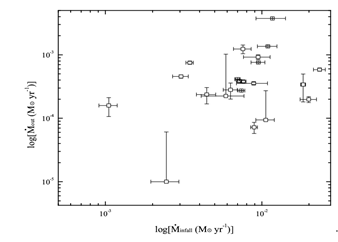

Effects of infall and outflow on massive star-forming regions
Star formation begins with the collapse of dense clumps, and forms much more dense cores in its center. At the same time, outflow driven by the star formation activities in the dense core will take some materials away from the dense core and help to remove the angular momentum from the dense core. So it is important to study the infall and outflow motions of the massive star forming clumps.
Researchers from star formation and evolution group of XAO identified 188 high-mass outflows from 694 massive star forming clumps in the Millimetre Astronomy Legacy Team 90 GHz survey, with the detection rate of approximately 27%. The detection rate of outflows increases from the proto-stellar stage to the H II stage, but decreases again at the photodissociation (PDR) stage. This suggests that outflows are being switched off during the PDR stage. An intimate relationship is found between outflow action and the presence of masers, and water masers appear together with 6.7 GHz methanol masers. Comparing the infall detection rate of clumps with and without outflows, we find that outflow candidates have a lower infall detection rate. Finally, we find that outflow action has some influence on the local environment and the clump itself, and this influence decreases with increasing evolutionary time as the outflow action ceases.

The correlation between the outflow mass rate and infall mass rate.
Paper link: https://academic.oup.com/mnras/article/488/4/4638/5538866
Attachment Download: